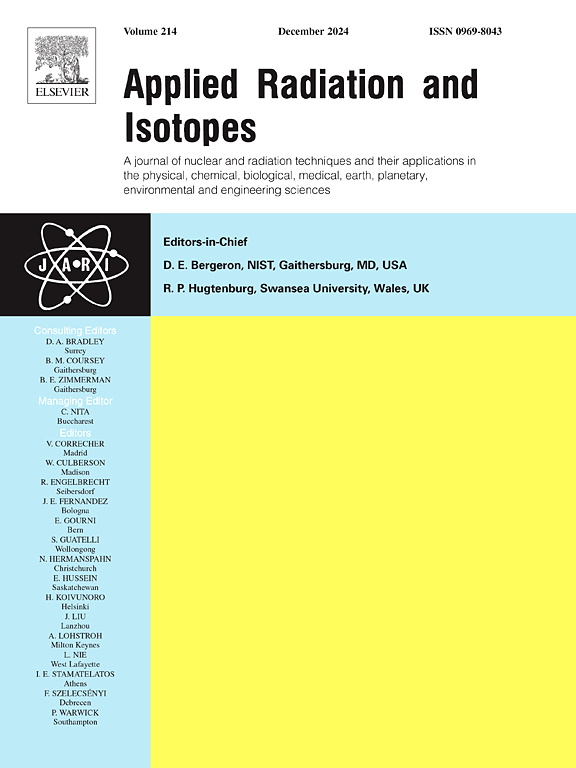Computational image analysis of kidney tissue samples of beagle dogs irradiated with 60Co gamma-rays
IF 1.6
3区 工程技术
Q3 CHEMISTRY, INORGANIC & NUCLEAR
引用次数: 0
Abstract
The advancements in the computational capabilities, over the past two decades, led to the intensification of research and practical application in the fields of computational image analysis and data classification. In particular, this approach is of interest in medicine, as it promises enhanced diagnostic accuracy and detection of subtle features. Alterations and patterns in medical images can be detected and quantified with precision. Additionally, the approach is markedly time saving and enabling of handling big amounts of data, giving new insights into the disease mechanisms and progression through data patterns and correlations.
Given relatively large quantities of data collected from radiobiology megastudies conducted in the past, we decided to subject some of these archival tissue specimens to computational image analysis in order to study in more detail structural changes in particular organs due to exposures to ionizing radiation. Here, we analyzed solid tissue samples of kidneys in beagle dogs irradiated with 60Co gamma-rays. We performed multifractal analysis, of the arrangements and shapes of cell nuclei, as well as tissue architecture in sections stained with hematoxylin and eosin. Although the dosing patterns differed, as well as the resulting days of survival and causes of death (not directly linked to the kidneys), we were able to quantify some of the structural changes present in the analyzed specimens. With the further analyses and more systematic study, we hope to form a base of knowledge on tissue structural modifications and typical values of tissue descriptors in various cases.
60Co γ射线辐照比格犬肾脏组织样本的计算图像分析
在过去的二十年中,计算能力的进步导致了计算图像分析和数据分类领域的研究和实际应用的加强。特别是,这种方法在医学上很有意义,因为它有望提高诊断准确性和检测细微特征。医学图像中的变化和模式可以精确地检测和量化。此外,该方法显着节省时间并能够处理大量数据,通过数据模式和相关性对疾病机制和进展提供新的见解。鉴于从过去进行的放射生物学大型研究中收集的相对大量的数据,我们决定对这些档案组织标本中的一些进行计算图像分析,以便更详细地研究电离辐射暴露导致特定器官的结构变化。在这里,我们分析了受60Co伽马射线照射的比格犬肾脏的实体组织样本。在苏木精和伊红染色的切片中,我们对细胞核的排列和形状以及组织结构进行了多重分形分析。虽然剂量模式不同,以及由此产生的生存天数和死亡原因(与肾脏没有直接联系),但我们能够量化分析标本中出现的一些结构变化。通过进一步的分析和更系统的研究,我们希望形成一个组织结构修饰的知识基础和组织描述符在各种情况下的典型值。
本文章由计算机程序翻译,如有差异,请以英文原文为准。
求助全文
约1分钟内获得全文
求助全文
来源期刊

Applied Radiation and Isotopes
工程技术-核科学技术
CiteScore
3.00
自引率
12.50%
发文量
406
审稿时长
13.5 months
期刊介绍:
Applied Radiation and Isotopes provides a high quality medium for the publication of substantial, original and scientific and technological papers on the development and peaceful application of nuclear, radiation and radionuclide techniques in chemistry, physics, biochemistry, biology, medicine, security, engineering and in the earth, planetary and environmental sciences, all including dosimetry. Nuclear techniques are defined in the broadest sense and both experimental and theoretical papers are welcome. They include the development and use of α- and β-particles, X-rays and γ-rays, neutrons and other nuclear particles and radiations from all sources, including radionuclides, synchrotron sources, cyclotrons and reactors and from the natural environment.
The journal aims to publish papers with significance to an international audience, containing substantial novelty and scientific impact. The Editors reserve the rights to reject, with or without external review, papers that do not meet these criteria.
Papers dealing with radiation processing, i.e., where radiation is used to bring about a biological, chemical or physical change in a material, should be directed to our sister journal Radiation Physics and Chemistry.
 求助内容:
求助内容: 应助结果提醒方式:
应助结果提醒方式:


